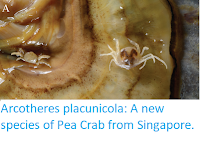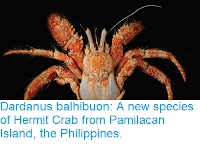Porcelain Crabs, Porcellanidae, are small Decapod Crustaceans closely
related to Squat Lobsters. They closely resemble True Crabs, Brachyura,
to which they are only distantly relates, an example of convergent
evolution. Porcelain Crabs have wide, flattened bodies, a shape which
enables them to hide in crevices, and large claws, which are used in
disputes with other members of the same species, but not for feeding.
Porcelain Crabs are rather delicate, and easily shed limbs to escape
predators, which gives them their common name.
In a paper published in the journal ZooKeys on 25 September 2019, Alexandra Hiller of the Smithsonian Tropical Research Institute, and Bernd Werding of the Institut für Tierökologie und Spezielle Zoologie at the Justus-Liebig-Universität Giessen, describe a new species of Porcelain Crab from the Caribbean coast of Colombia.
The new species is placed in the genus Petrolisthes, and given the specific name virgilius, in honour of Virgilio Galvis Ramírez, for his support and interest in research on marine Crabs, and for his contributions to medical sciences in Colombia. The species is described from a population in the Gulf of Urabá previously assigned to the species Petrolisthes tonsorius, which inhabits the rocky intertidal of both the Caribbean and the tropical East Pacific and exhibits a brown to dark-brown colour, sometimes blueish, while the Gulf of Urabá population is pale brown to beige. A DNA analysis carried out by Hiller and Werding confirmed that this is a new species.
Petrolisthes virgilius, Colombia, Santa Marta. Scale bar is 2.4 mm. Hiller & Werding (2019).
The species is described from five specimens, three males and two females, with the males measuring between 3.3 and 4.6 mm in length and the females between 4.3 and 5.3 mm, although males as large as 8.1 mm and females as large as 6.5 mm have previously been recorded. The species was found exclusively in intertidal formations of Vermetid (Worm) Snails exposed to strong waves.
See also...
Follow Sciency Thoughts on Facebook.







